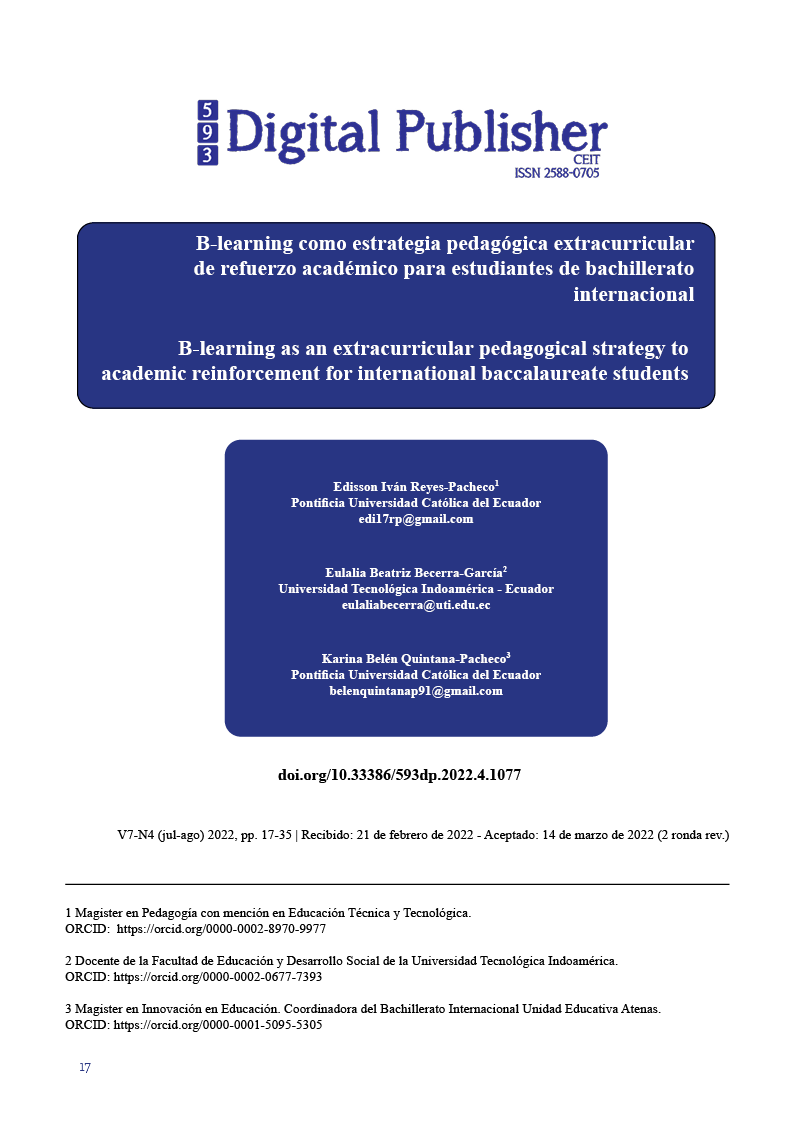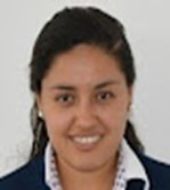B-learning as an extracurricular pedagogical strategy to academic reinforcement for international baccalaureate students
Main Article Content
Abstract
The research has the aim to determine the efficiency level of the b-learning methodology as an extracurricular pedagogical strategy in the teaching learning process of the International Baccalaureate Math students; with the main intention of executing the online continuous learning in relation to a plan established by the International Baccalaureate Organization during the COVID-19 pandemic. Hence, it is proposed to develop an intervention proposal in the Math teaching-learning process, through the b-learning methodology and expose to a pre-experimental design test directed to 29 third-year high school students who are studying the International Baccalaureate Diploma Program in Analysis and Approaches SL (Standard Level) in the specialties of Engineering and Administration, whom after a diagnosis testing will be exposed to an educational intervention through b-learning to get results that allow assessing, if there is an evident increase in academic performance between the pre-test and the post-test for the same group. The Shapiro-Wilk normality test and the Wilcoxon nonparametric statistical test are applied to compare their medians, the pretest average is 3.5 meanwhile the postest is 7. Consequently, it is identified that the p- value is less than or equal to 0.05; therefore, the null hypothesis is rejected, and the alternative hypothesis is accepted. Thus, asserting that there are significant changes regarding the fact that the b-learning methodology as an extracurricular pedagogical strategy, reinforces the teaching-learning process of Math in high school students of the International Baccalaureate.
Downloads
Article Details

This work is licensed under a Creative Commons Attribution-NonCommercial-ShareAlike 4.0 International License.
1. Derechos de autor
Las obras que se publican en 593 Digital Publisher CEIT están sujetas a los siguientes términos:
1.1. 593 Digital Publisher CEIT, conserva los derechos patrimoniales (copyright) de las obras publicadas, favorece y permite la reutilización de las mismas bajo la licencia Licencia Creative Commons 4.0 de Reconocimiento-NoComercial-CompartirIgual 4.0, por lo cual se pueden copiar, usar, difundir, transmitir y exponer públicamente, siempre que:
1.1.a. Se cite la autoría y fuente original de su publicación (revista, editorial, URL).
1.1.b. No se usen para fines comerciales u onerosos.
1.1.c. Se mencione la existencia y especificaciones de esta licencia de uso.
References
Adaobi, I., Spangenberg, E., & Ramdhany, V. (2020). Blended Learning Approach to Mathematics Education Modules: An Analysis of Pre-Service Teachers’ Perceptions. International Journal of Learning, Teaching and Educational Research, 19(7). doi:https://doi.org/10.26803/ijlter.19.7.17
Alberico, J. (2017). El B-learning en el nivel primario: un diálogo entre la educación presencial y la educación a distancia., : Brujas. (1 ed.). (Brujas, Ed.) Buenos Aires, Argentina.
Ardila, J., Ruiz, E., & Castro, I. (2015). Estudio comparativo de sistemas de gestión del aprendizaje: Moodle, ATutor, Claroline, Chamilo y Universidad de Boyacá. Revista Academia y Virtualidad, 8(1), 54-65.
Attard, C., & Holmes, K. (2020). An exploration of teacher and student perceptions of blendedlearning in four secondary mathematics classrooms. Math Ed Res J. doi:https://doi.org/10.1007/s13394-020-00359-2
Blasco, P. (2006). Estrategias psicopedagógicas para la atención a la diversidad en Educación. (S. Edicions Culturals Valencianes, Ed.) Valencia, España: Nau Libres.
Cabero, J., & Llorente, M. (2008). Del e-learning al blended Learning: nuevas acciones educativas. Quaderns Digitals, 51.
Camarillo, H., & Barboza, C. (2020). La enseñanza-aprendizaje del derecho a través de una plataforma virtual institucional: Hallazgos incipientes del constructivismo de Piaget, Vygotsky y Ausubel conforme a las percepciones de los informantes. Revista pedagogía universitaria y didáctica del derecho, 2, 143-165. doi:10.5354/0719-5885.2020.57035
Castellanos. (2017). Obtenido de https://www.academia.edu/31152068/Contextualizaci%C3%B3n_de_la_Educaci%C3%B3n_Virtual_en_Ambientes_Hipermediales
Cerón, M., Narváez, C., & Romero, W. (2016). B-Learning nivelatorio matemático: “Una estrategia pedagógica para mejorar los desempeños académicos y las competencias en los estudiantes de instituciones de educación superior”. Cali: UNICUCES. Obtenido de www.unicuses.edu.co
Coronel, M., & Curotto, M. M. (2008). La resolución de problemas como estrategia de enseñanza y aprendizaje. Revista Electrónica de Enseñanza de las Ciencias, 7(2), 17. Retrieved from http://reec.uvigo.es/volumenes/volumen7/ART11_Vol7_N2.pdf
Davis, R. (1999). El don de la dislexia: Nuevo método para corregir la dislexia y otros problemas de aprendizaje. Madrid, España: Editext, ed.
Eleizalde, M., Parra, N., Palomino, C., Reyna, A., & Trujillo, I. (2010). Aprendizaje por descubrimiento y su eficacia en la enseñanza de la Biotecnología. Revista de investigación, 71, 271-290. Obtenido de https://www.redalyc.org/articulo.oa?id=376140386013
Escudero, S., Marazzo, J., Pompei, S., & Peri, J. (2015). Las Tics en la enseñanza de las ciencias exactas y naturales. SEDICI. Obtenido de http://sedici.unlp.edu.ar/handle/10915/46270
Fernández-Plaza, J., Castro, E., Estrella, M., Martín-Fernández, E., Rico, L., Ruiz Hidalgo, J., & Vílchez-Marín, M. (2016). Significados y concepciones de conceptos matemáticos escolares. Investigación en Educación Matemática XX. 237-246. Obtenido de http://funes.uniandes.edu.co/8863/1/Castro2016Significado.pdf
Gómez, R. (2002). Análisis de los métodos didácticos en la enseñanza. Publicaciones, 32, 261-333. Obtenido de https://revistaseug.ugr.es/index.php/publicaciones/article/view/2334/2495
Gonzáles, M. (2015). El b-learning como modalidad educativa para construir conocimiento. Redalyc, 31(2), 501-531. Obtenido de https://www.redalyc.org/articulo.oa?id=31045568029
Guerrero, A. (1973). El sistema psicológico de B. F. Skinner. Revista Latinoamericana de Psicología, 5(2), 191-216. Obtenido de www.redalyc.org/articulo.oa?id=80550206
Hattie, J., & Timperley, H. (2007). The power of feedback. Review of Educational Research. Obtenido de http://growthmindseteaz.org/files/Power_of_Feedback_JHattie.pdf.
Hernández, G., Sánchez, P., Rodríguez, E., Caballero, S., & Martínez, M. (2014). Un entorno b-learning para la promoción de la escritura académica de estudiantes universitarios. Revista Mexicana de Investigación Educativa RMIE, 19, 351. Retrieved from http://www.scielo.org.mx/pdf/rmie/v19n61/v19n61a2.pdf
Kashefi, H., Ismail, Z., Yusof, Y., & Rahman, R. (2012). Supporting Students Mathematical Thinking in the Learning of Two-Variable Functions Through Blended Learning. Procedia-Social and Behavioral Sciences, 46, 3689-3695. doi:https://doi.org/10.1016/j.sbspro.2012.06.128
Kashefi, H., Ismail, Z., Yusof, Y., & Rahman, R. (2012). Supporting Students Mathematical Thinking in the Learning of Two-Variable Functions Through Blended Learning. Procedia - Social and Behavioral Sciences, 46, 3689-3695. doi:https://doi.org/10.1016/j.sbspro.2012.06.128
Lancheros, S. (2014). Aplicación de un modelo de clase b-Learningpara el aprendizaje de la matemática. Obtenido de www.ilae.edu.co
Martínez, S., Guíñez, F., & Zamora, R. (2020). On the instructional model of a blended learning program for developing mathematical knowledge for teaching. ZDM Mathematics Education52, 877-891. doi:https://doi.org/10.1007/s11858-020-01152-y
Mashhadi, V., & Kargozari, M. (2011). Influences of digital classrooms on education. Procedia Computer Science, 3, 1178-1183. doi:https://doi.org/10.1016/j.procs.2010.12.190
Ministerio de Educación. (2020-2021). Ministerio de Educación del Ecuador. Obtenido de https://educacion.gob.ec/wp-content/uploads/downloads/2020/09/Lineamientos-Plan-Educativo-Aprendemos-juntos-en-casa-Ciclo-Sierra-Amazonia
Muñoz, J., & Gairín, J. (2013). Orientación y tutoría durante los estudios universitarios. El Plan de acción tutorial, 171-192.
Oliva, H. (2015). El refuerzo educativo (1 ed.). El Salvador: UFG.
Organización del Bachillerato Internacional. (2019). www.ibo.org. Obtenido de https://www.ibo.org/contentassets/482577848e9c4fb0b7d1ee057f2482f3/what-is-an-ib-education-2017-es.pdf
Organización del Bachillerato Internacional. (2020). ibo.org/es. Obtenido de https://www.ibo.org/globalassets/news-assets/coronavirus/online-learning-continuity-planning-es.pdf
Organización del Bachillerato Internacional. (2020). ibo.org/es. Obtenido de https://www.ibo.org/globalassets/news-assets/coronavirus/online-learning-continuity-planning-es.pdf
Organización del Bachillerato Internacional. (2021). www.ibo.org/es. Obtenido de http://www.apc.edu.ec/wp-content/uploads/2020/06/Guia-Matematicas-2021.pdf
Organización del Bachillerato Internacional. (2021). www.ibo.org/es. Obtenido de http://www.apc.edu.ec/wp-content/uploads/2020/06/Guia-Matematicas-2021.pdf
Palella, S. (2012). Metodología de Investigación Cuantitativa. Fedupel.
Pérez, A., Valdés, M., & Garriga, A. (2019). Estrategia didáctica para enseñar a planificar los procesos de enseñanza y aprendizaje de la matemática. Revista Educación, 43(2), 1-30. doi: https://doi.org/10.15517/revedu.v43i2.32236
Piaget, J. (1977). Psicología del niño. Madrid, España: Ediciones Morata.
Quinn, D., & Aarão, J. (2020). Blended learning in first year engineering mathematics. ZDM Mathematics Education52, 927-941. doi:https://doi.org/10.1007/s11858-020-01160-y
Ramírez, F., & Rama, C. (2014). Los recursos de aprendizaje en la educación a distancia: Nuevos Escenarios, Experiencias y Tendencias (1 ed.). (F. R. Rama, Ed.) Lima, Perú: UAP. Obtenido de https://virtualeduca.org/documentos/observatorio/2014/los-recursos-de-aprendizaje
Rica, C., Rodriguez, O., Cuicas, M., & Debel Chourio, A. (2010). Actualidades Investigativas en Educación. El modelo b-learning aplicado a la enseñanza del curso de matemática en la carrera de ingeniería civil. Obtenido de http://revista.inie.ucr.ac.cr
Smith, P., & Ragan, T. (1999). Instructional design. (A. Alfonzo, Ed.) New Jersey: Merrill Prentice Hall, 2. Obtenido de http://planificacionse043.blogspot.com/2015/06/estrategias-instruccionales.html
The Institute of Education Sciences (IES). (2009). Assisting Students Struggling with Mathematics: Response to Intervention (RtI) for Elementary and Middle Schools. (U. D. Education, Ed.) What Works Clearinghouse, 1-104. Obtenido de https://ies.ed.gov/ncee/wwc/Docs/PracticeGuide/rti_math_pg_042109.pdf
Vega Vega, J., Niño Duarte, F., & Cárdenas, Y. (2015). Enseñanza de las matemáticas básicas en un entorno e-Learning: un estudio de caso de la Universidad Manuela Beltrán Virtual. Revista EAN, 79, 172-187. Obtenido de http://www.scielo.org.co/scielo.php?script=sci_arttext&pid=S0120-81602015000200011&lng=en&nrm=iso&tlng=es
Vigotsky, L. (1988). El desarrollo de los procesos psicológicos superiores. México: Grijalbo.




